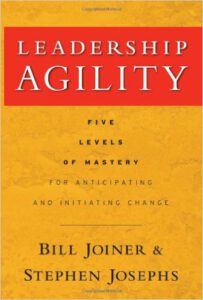Are you familiar with VUCA? Do you wonder what this four letter acronym means? If you know what it is, just skip the following paragraph and continue reading further down.
The usage of the term VUCA began in the 1990s. It originates from military vocabulary and has been subsequently used in emerging ideas related to strategic leadership thinking. VUCA is often used to describe how people view the conditions under which they make decisions, plan forward, manage risk, foster change and solve problems.
The meaning of the four letters in the acronym is:
 = Volatility. The nature and dynamics of change, i.e. what forces and catalysts act to cause change and how they themselves alter with time.
= Volatility. The nature and dynamics of change, i.e. what forces and catalysts act to cause change and how they themselves alter with time.
 = Uncertainty. The lack of predictability, the prospects for surprise, and the sense of awareness and understanding of issues and events.
= Uncertainty. The lack of predictability, the prospects for surprise, and the sense of awareness and understanding of issues and events.
 = Complexity. The multiplex of forces, the interaction of issues and the chaos and confusion that surround an organization (and can also exist within it).
= Complexity. The multiplex of forces, the interaction of issues and the chaos and confusion that surround an organization (and can also exist within it).
 = Ambiguity. The haziness of reality, the potential for misreads, and the mixed meanings of conditions; cause-and-effect confusion.
= Ambiguity. The haziness of reality, the potential for misreads, and the mixed meanings of conditions; cause-and-effect confusion.
What is the impact of VUCA on today’s and tomorrow’s leaders?
Considering all these aspects of a VUCA world it becomes very clear that one of the key success factors for a leader working in such a context must be the person’s mental flexibility and openness, in other words his/her agility. Here agility means the power of moving quickly and easily, taking decisions on the fly and operating with high flexibility in order to adjust to rapid changes of the context. How can you, as a leader be ready to take the VUCA challenges head on? And what does agility mean in your leadership context?
Rather then treading a beaten track, in this blog post I have decided to present a book about leadership agility which describes exactly what I consider important for leaders who want to become skilful when operating in a VUCA world.
It was written by William B. Joiner and Stephen A. Josephs.
The title of the book is:
Leadership Agility: Five Levels of Mastery for Anticipating and Initiating Change
Let me summarise my view on the key messages from this book:
The authors describe an agile leader as fully present “in the moment,” with the ability to engage with events, yet, at the same time being able to step back and see problems from different perspectives.
All aspects of the book are built on two corner stones:
The first corner stone is that Joiner and Josephs approach leadership agility and its development through an integral approach. One part is the classical ‘Outside In’ competency development. Learning the craftsmanship of leadership by aquiring skills and competencies through training in all sorts of settings. The second more integrative part is the ‘Inside Out’ development of deeper mental capacities. Gaining deep insights about oneself, personal drivers and believes as well as a deeper sense of purpose.
The second corner stone is the theory of stage development of human beings when growing up, which emerged in the late 1950s from Erik Erikson et al.. Joiner and Josephs relate their leadership agility levels, described further down, relatively close to these development stages.
The authors describe research which involved more than 600 managers. In that study, they analysed the agility and its quality demonstrated by the participating candidates in connection to three critical areas of leadership effectiveness which they classify as pivotal conversations, team initiatives, and organisational initiatives.
Results of the study:
The analysis of the study data enabled them to distinguish five levels of leadership agility, as follows:
The first (and lowest) level is headlined as “Expert”. About 45% of all leaders operate on this level of leadership agility. Those leaders are very often drawn into solving problems using their extensive knowledge accumulated over time. Knowing and focusing on details are as important for them as the leadership position itself they hold.
The second level is described as the “Achiever”. Leaders at the achiever level – about 35% of all– move beyond the expert’s knowledge and his behaviour as they develop the ability to also see the bigger picture and be more reflective, hence, opening up to differing perspectives. In their role as a leader, achievers see more the need to motivate and inspire others.
The third level is specified as the “Catalyst”. Those on this level are sufficiently agile to succeed over the long term; only about 5% of all leaders reach this stage. Catalysts are, as the name suggests, more on the side of initiating or setting goals for teams and facilitate their success, and challenging their own assumptions in consideration of others’ perspectives.
The fourth level is labelled “Co-Creator”. Co-Creators –roughly 4% of all leaders– have the ability to understand what connects the business world with all the other aspects of society and life in general. This enables co-creators to amalgamate different perspectives in challenging situations, superficially highly complex and chaotic, and shaping more integral solutions for business and society.
The fifth and highest level is called the “Synergist”. Based on the authors’ analysis, only 1% of all leaders have reached the stage of the synergist. At this level of agility, the leader has developed extraordinary qualities of sustained awareness of the whole context and present moment. Volatility does not affect their calm. Their intuitive capacity enables them to find beneficial solutions even in the most paradoxical settings.
Now what?
You may wonder how this could help you in your day-to-day life as a leader of an organisation where being more or less constantly at the brink of turmoil requires quick action and flexibility in thinking and doing. I consider the above-described levels of agility very helpful in order to determine at what level of agility you currently manage and to reflect what level you would want to reach, considering the challenges you face within your organisation. Hence, it helps to map the territory for your journey of leadership development.
The authors’ advice regarding the development of leadership agility:
In the above-mentioned study the authors also determined that in order to move forward in your levels of agility you should concentrate on four competency areas within which to develop the skills driven by your mental and emotional capacities.
The four competency areas are:
- “Self-leadership agility”
- “Stakeholder agility”
- “Context-setting agility”
- “Creative agility”
Want to explore further?
In order to develop these competency areas progressively and ultimately to master them, a very individualised programme of a mix of training modules, action learning groups and personal coaching may be the best solution for you.
I can recommend every leader to read this book as a first orientation in the subject matter. Or feel free to get in touch with us and have an exploratory conversation about how -in your specific circumstances- you can develop your leadership abilities to meet the challenges of your VUCA world most effectively. Through dedicated training and coaching support you can get a sense of fulfilment in your leadership role.




